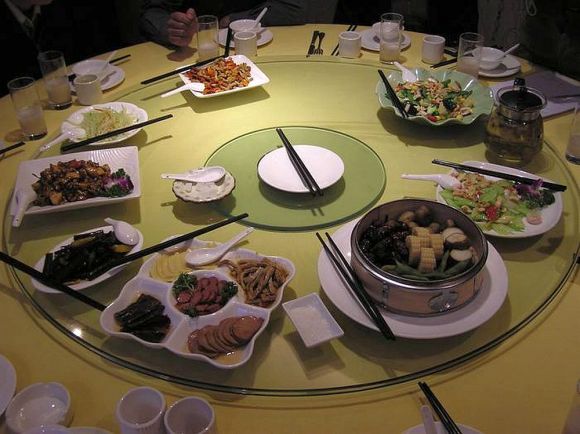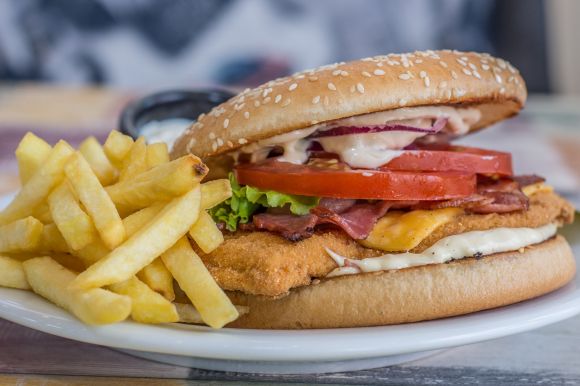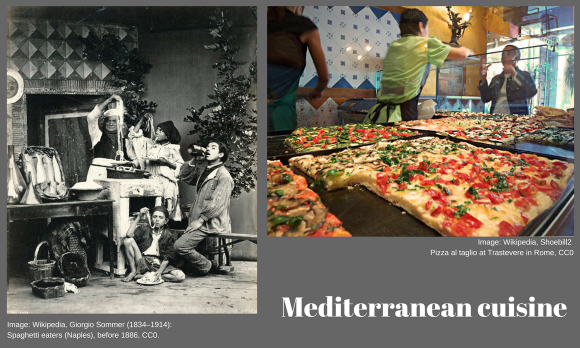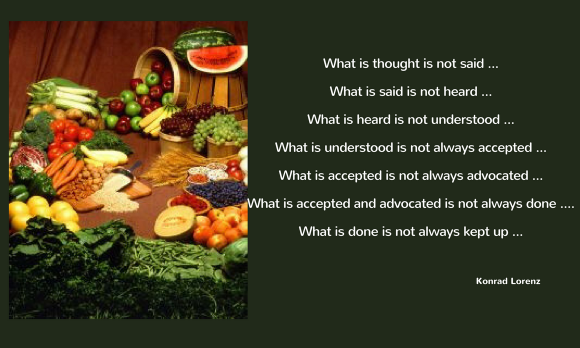1 Nutrition
Basic information about our diet, list of significant change options based on levels of nutrition.

Table of contents
About these articles
This article and the nine subsequent articles were written in 2000. They were written for the website www.rohkost.ch (in German only), which my son set up when he was 13 years old. Today, at the end of 2013 (beginning of 2014), I see things differently: If I want to help others achieve better long-term health, I need to start at the place where readers are likely to currently be.
In the other articles, I describe significant steps to take that are not as drastic as a total change of diet. Please simply look through the articles on raw foods and concentrate on those that interest you most. But if you are indeed interested in raw food, then you will be able to find what you need to know in the following articles. I revised these ten related articles on raw food in 2014. All the other articles have been written recently.
You can get further information by clicking on the links, most of which will bring you to Wikipedia. It is important to know that Wikipedia posts are often slanted and unbalanced when it comes to topics central to the industry. Special interest forces are the momentum behind such topics. At the end of each article, there is the option for you to send comments, either to us or for publication.
Conclusion
This introduction to the field of nutrition will teach you how to distinguish between the different diets in the Western world.
You will find out about the problems that common types of diets have. And you will learn to distinguish between significant and insignificant aspects. Other articles on topics other than raw food will be added gradually, such as the book reviews linked below and other blogs (German only).
There are many different diets and food traditions. In China, for example, it is common for people to sit at round tables when they eat meals together. The photo shows one with a rotating glass surface. This is an image I took myself when I was in China. I had been invited there by Chinese collectors and friends.
1. Our diet types
In contrast to earlier times, the food in the “Western world” is normally quite diverse. However, there are essentially only two basic types of diets: cooked or heated and raw.
With both of these, you can eat almost any type of food (omnivores), that is meat, fish, eggs, milk, dairy products, and plant-based products. But there are also people who cut out certain foods or have special eating habits. And also people who go on diets for a specific length of time to achieve certain goals, such as losing weight or curing themselves.
- Examples of raw meat eaten as part of a raw food diet include steak tartare and carpaccio, a specially prepared raw meat. People eat raw fish in the form of sashimi, pickled herring, (also known as Bismarck herring), dried cod, anchovies as Boquerones en vinagre, and, for those who like it, Surströmming.
- Raw foodies, or people who exclusively or predominantly eat a raw food diet, are often vegetarian or even vegan. For both types of diets, cooked food and raw food, there are also ovo-lacto vegetarians who eat eggs and dairy products and lacto vegetarians who don’t eat eggs. Some other categories also exist; I will discuss these below.
- Vegans are people who don’t consume animal products of any kind. But even here you will encounter some differences. For example, some people use honey and others don’t. And there are also intermediate forms with both raw food and cooked food diets, such as eating fish but not meat. Most vegetarians and vegans are not raw foodies.
- Cooked food can be even further subdivided into the categories of factory food (convenience foods), foods eaten away from home (e.g., in cafeterias and restaurants), regular cooked foods, whole foods, slow-cooked food, and foods for various diets (natural cures, weight-loss diets, and diet fads). Ecological-minded people in all categories try to purchase foods in organic quality and, if possible, local products.
All of these diets can be approached very differently. But poor choices can lead to eating an imbalanced diet, too large of quantities, or the wrong combination of foods — all of which are bad for our health.
As paradoxical as this may sound, there are scientists today who say that our first step should be to reduce or omit milk and dairy products. Ms. Rollinger seems to have written the best book on the subject with "Milch besser nicht!" (Milk, better not!), and you can find the book review here.
2. Answers to the worst type of diet: fast food (junk food)
I would first like to share some book reviews with you. The following books are addressed to those readers who consume mainly convenience foods, soft drinks or energy drinks, trendy beverages, and snack foods:
- Salt Sugar Fat by Michael Moss,
- Lügen, Lobbies, Lebensmittel (Lies, lobbies, food) by Ingrid Reinecke and Petra Thorbrietz (portrays the situation in Europe),
- Die Ernährungslüge (The diet lie) by Hans-Ulrich Grimm (deals mainly with the harmful ingredients contained in food).
Simply click on the links to go to the book reviews. At most, this type of diet should be a rare exception, but the current situation looks very different.

3. Regular cooked food
The discussion of the problems with “regular cooked food” is still a work in progress. You will soon be able to find links to book reviews and other articles on the subject.
The great majority of people in “rich” countries have the opportunity to eat the foods that meet their body’s needs. However, in practice, the current situation is quite different.
And nutrition research has developed in only a very circuitous manner. Fortunately, there has recently been a change in direction in this field toward a healthier diet.
It takes many years for new knowledge to gain currency. Wikipedia has now taken a more modern stance on the subject of human nutrition as compared to before.
Unfortunately, some findings are adopted by consumers in such a way that a new “belief” or “fad” is created. Even though “new nutrition knowledge” is mostly accurate on specific topics, it often does not truly reflect reality in its statistics or secondary literature publications. There is definite confusion (tohu wa bohu) on the subject of the “right” diet. And many people simply eat foods part of their regional cuisine.
An example based on Mediterranean cuisine:
A few years ago, scientists examined why Latin peoples (such as the French) have a much lower risk of dying from a heart attack or similar event than “Nordic” peoples. The study found the reason to be Mediterranean cuisine, which can be reduced to olive oil, lots of raw ingredients, and regular wine consumption — as a “heart stimulant.”
If you compare the average life expectancy and the causes of death between the Swiss and French, you see the facts. The statistical life expectancy in Switzerland as of November 2013 is exactly 82.28 years from birth (79.99 for males / 84.71 for females), and in France it is 81.65 (78.45 / 84.28). The heart is not the only deciding factor, but the goal of this study was to investigate the causes of frequent heart attacks. Period.

The person as a whole doesn’t play a role here because the study is detached from an overall assessment of the general health of a population. There are simply too many parameters that come into play.
The authors of the study are not held responsible for the fact that special interest groups may misinterpret it or publish false conclusions. And parties with an economic interest do not weigh the pros and cons, but instead unilaterally publish only the benefits. Unfortunately.
Moderation is the only determining factor
People now talk about “healthy” Mediterranean cuisine and “good wine” and tend to forget that “everything is healthy and everything is harmful — moderation is the only determining factor.”
“No,” you say? Here is another example: according to dietetics, hydrocyanic acid is an essential nutrient, as is lead, only we get too much of it rather than too little.
Back to the Mediterranean diet. I don’t want to discourage this type of diet. It is, of course, much better than junk food or most convenience foods. But pizza, pasta, and alcohol should play a very minor role in your diet.
The question that remains is as follows: are there indeed better forms of nutrition?
In the West, we know that our body usually receives “too much of a good thing.” But how many people do anything about this?
Perhaps over time, we realize from the size of our waistlines that something is wrong. But how are we to notice this, since so many others around us are eating too much and, in particular, too much salt, sugar, and fat?
4. A list of major nutrition mistakes
The five different levels of eating described in the text next to the image below show significant differences. In other words, if we move from one type of diet down to the next, we are already making a major improvement, provided the quantity and combination of foods are well thought through.
The selection (and combination) of foods is also a critical factor. This is why I have listed out negative aspects next to each different type of diet. People can generally find many ways to improve their diet, and significant improvements can also be made within the same level.
So what mistakes do people make? Please see the text next to the image.
| Consuming primarily convenience foods and drinking too many sweetened drinks Using the wrong ingredients when cooking common foods Eating a poor vegetarian diet (e.g., pudding vegetarians) Having poor eating habits as a vegan Eating an imbalanced raw food diet |
In addition, we can also add eating too much and too much fat, sugar, and salt to the list.
These are the most important aspects to be aware of under the negative descriptors above. Of course, the list can be extended to categories such as organic and local, but these can be seen as “further refinements” that have a particularly positive impact on nature and the environment, but do less for your health.
5. Drugs and indulgence foods are a different problem
In this section, I will not be discussing drugs or indulgence foods. This is a separate subject that goes from hard drugs and potent toxins to the drugs (now) accepted by society. Giving up hard drugs, but also less harsh and other addictive substances such as tobacco or alcohol (alcoholism in various forms) is an even more important and significant step toward long-term health. These will be discussed at a later point along with indulgence foods, which are eaten only for their taste as opposed to any nutritional value. These are also harmful if consumed regularly or in excess.
I realized how risky and naive people behave when a radiologist I knew died of early lung cancer (pulmonary carcinoma). As a smoker and co-owner of an X-ray institute, every day he saw the damage caused by smoking ...
But most people usually have a particularly well-developed brain, at least compared to a mouse.

These mice can actually find more than enough “ordinary food,” but “something special” is more in demand! We recognize the risk, but we often behave the same way.
6. Family and society influence us
We don’t usually compare ourselves with people who have eaten a healthy diet for many years, but instead measure ourselves against the majority. And how can we know if we are eating just a few grams too much every day?
Through common wisdom and advertisements, in particular, we think we are doing the right thing, perhaps in some cases slightly in excess, but what the heck. Fortunately, in recent decades, the recommendations and also people’s eating habits have moved more toward raw food and thus a healthier diet. The trend is going in the right direction.
Understanding results from knowledge and seeing the logic of the relevant relationships, and also from knowing about the background and history of how these ideas came to be. Many people think they know certain things, but they don’t truly understand.
This “knowledge” then contains the power of belief. But this “knowledge” may be true or untrue, or only partly true.
Perhaps you may start to question certain “truisms” and, with time, will arrive at entirely different views. But you need to have good reasons to back these up. The word “truism” generally denotes a fact that is commonplace knowledge, obvious, or self-evident. Entire books have been written to debunk certain truisms and prove them wrong.
Well, these people believe in something mystical that they got from others and often miss reality entirely. They either ignore critical thinking or do not have the faculties to engage in such. They stress matters of secondary importance and forget the main issue.
I cannot invent anything new either, but have to turn to the work of my predecessors, which is sometimes difficult to assess. But I do not adopt anything without critical inspection, and don’t just believe ideas because they have been repeated by many sources hundreds of times.
After I changed my diet and was able to observe extraordinary results in my own body and hear about similar experiences that friends and acquaintances had, I have come to other conclusions. But to be credible, I have to be able to justify my reasons in detail.
Otherwise, what would a few random experiences be against the arguments of the overwhelming majority of doctors? These and other “competent” people should have a deeper level of knowledge.
Will you take the time to go through this? In the last decade, in particular, science has gained fundamental new insights. Some of these findings are turning well-known “truths” upside down.
It wasn’t until I was already 41 years old, in 1978, that I came to the painful realization that the lifestyle habits we have cause diseases of civilization. It was then that I was given a statistical life expectancy of just under three years. You can read more about my experience in this article.
"If the doctors didn’t have a way to save me, then I would have to go an entirely different route"
At the time, I didn’t understand the factors that made up this poor lifestyle. But I was fully convinced that:
if the doctors didn’t have a way to save me, then I would have to go a completely different route — one that would be most effective for the body and mind.
Yes, but what would that look like? Aha! I needed to introduce changes to my diet because my body is practically exclusively made up of the things I’ve eaten in the past!
For several years, I only had a certain amount of hope, not any real faith. I hadn’t fallen into an abyss of belief like Gowinda in Hermann Hesse’s novel Siddhartha. That seems to be an important factor as well as the realization that raw food by itself formed only part of the “expectation therapy” (expectation therapy or expectation treatment). Perhaps the mental factor was just as important or even more important. Who knows?
Then I began to read literature on alternative nutrition and immersed myself in textbooks on nutritional science. At that time, there was a gap between the claims of nutritional science and the thousands who for reasons of faith had lived on a strictly vegan or lacto-vegetarian diet for many generations.
- A good example is Jainism, a religion that is over two and a half thousand years old. The Jain movement, currently several million people strong, is a little older than Buddhism. It is only now that nutritional science is more advanced that I can support a vegan raw food diet with good evidence and new scientific findings.
Nevertheless, I am sure you know how angry addicted smokers who don’t have “momentary perspective” tend to get when you tell them they need to stop smoking. With the phrase “a lack of momentary perspective,” I am referring to their attitude or rather inner belief that they won’t be able to make the change. They probably can’t admit to it, but they inwardly know that they are addicted — in other words, they can’t change their actions. This is similar to a drug addict or alcoholic.

I can therefore expect that my articles about “a better way” may also provoke negative reactions. Unfortunately, it then doesn’t matter if my statements are well-founded or not.
I want to describe a path in such a way that it will be read by independent-thinking people, in other words, by critical people who do not just believe — or don’t believe. The problem? Opportunities to significantly change our eating habits stand in contrast to a myriad of simple to use “straws.” Straws here refer to ineffective or barely effective measures to which people grasp. This significant distinction seems to me to be sorely needed, and realizing this is the only path to successful treatment.
I hope many people will find these articles to be of interest. What does that mean? I believe that if even just one-tenth of a percent could be reached, the undertaking would be justified. And if then from this number, one percent improved their eating habits by one significant level, it would be worth the effort. More than a thousand people with direct health benefits would be the result.
I look forward to your responses via the provided comment option below. I rely on various suggestions from readers. In time, we will have the option to answer your comments directly, as well as the possibility to email you when a new post appears. Thank you for your help.



Comments